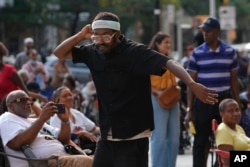In the 1970s, a lack of community investment resulted in a large number of people leaving Harlem, a well-known New York City neighborhood in northern Manhattan.
Nearly 50,000 people, about a third of the area’s population, left to escape violence, crime and poor living conditions. Among those who left was LeeSandra Moore’s mother who moved to the state of Virginia. “It was a scary time,” said Moore, now 52 and still living in Harlem. “I couldn’t blame her for that.”
Those who stayed were mostly poor, Black families. They lived through unrest that followed the 1964 killing of an unarmed Black teenager and the killings of Black leader Malcolm X in 1965 and Rev. Martin Luther King Jr. in 1968.
News reports described Harlem as a “sinking ship.”
Percy Sutton was president of the local Manhattan government at the time. As the city’s highest-ranking Black official, he knew Harlem needed a lift and started a festival called Harlem Day in 1974.
Sutton called up elected officials. He gathered actors, like Sidney Poitier and Ruby Dee, entertainers, including Tito Puente and Max Roach, and the poet Maya Angelou to celebrate the first Harlem Day. It honored Harlem's history and shows how the neighborhood became known as "Black Mecca” or the center of Black arts, culture and businesses.
“It was such a successful day,” said Lloyd Williams — one of Harlem Day’s co-founders and the current president of the Greater Harlem Chamber of Commerce — that it became a week-long yearly event called Harlem Week.
The festival’s 50th year
This year, Harlem Week celebrated its 50th anniversary with 18 days filled with free programming.
The celebration included food, Broadway performances, an Apollo Hour, and a tribute to entertainer Harry Belafonte. It offered financial education and career training, and for children, back-to-school backpacks.
One important part of Harlem Week was an effort to deal with Harlem's long-standing health crises. Medical volunteers checked blood pressure and tested for cancer and diabetes. People learned about drug use, HIV/AIDS and healthy aging.
Rev. Al Sharpton leads the National Action Network in Harlem. He said, "Harlem Week has been the constant line through the last 50 years of America's most historic Black neighborhood."
Organizers and people say Harlem Week has brought new life to the area. The once-deserted neighborhood is now home to restored buildings, new businesses, and immigrants. The streets are filled with jazz, reggae, R&B, and gospel music traditions.
Big stores vs. small shops
Moore, the Harlem native whose mother moved to Virginia, watched as big national stores moved in. Sometimes they took the place of local shops and made rents go up. "Some of that is okay, but what about the small business where you can get that great sandwich?" she asked. Moore wants people to eat less fast food, so she teaches healthy eating and cooking to young local students.
At Harlem Week, Moore represented GirlTrek, a national movement of Black women supporting health through walking. She said, "I feel like I should have left a long time ago, but something about Harlem draws me back to it."
Moore continued, "Harlem is my beginning. Harlem is my future. Harlem is a huge part of what makes me who I am."
I’m Jill Robbins.
Ryan Doan-Nguyen reported this story for the Associated Press. Jill Robbins adapted it for Learning English.
______________________________________________
Words in This Story
scary- adj. causing fear
rank – v. to place (someone or something) in a particular position among a group of people or things that are being judged according to quality, ability, size, etc.
festival - n. a special time or event when people gather to celebrate something
What do you think of this story? Write to us in the Comments Section.











Forum